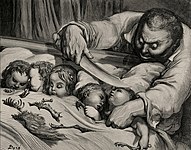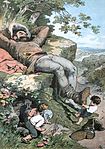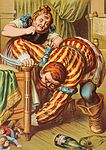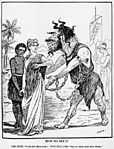Ogre

An ogre (
In mythology, ogres are often depicted as inhumanly large, tall, and having a disproportionately large head, abundant hair, unusually colored skin, a voracious appetite, and a strong body. Ogres are closely linked with giants and with human cannibals in mythology. In both folklore and fiction, giants are often given ogrish traits (such as the giants in "Jack and the Beanstalk" and "Jack the Giant Killer", the Giant Despair in The Pilgrim's Progress, and the Jötunn of Norse mythology); while ogres may be given giant-like traits.
Famous examples of ogres in folklore include the ogre in "
Etymology

The word ogre is of French origin, originally derived from the Etruscan god Orcus, who fed on human flesh. Its earliest attestation is in Chrétien de Troyes' late 12th-century verse romance Perceval, li contes del graal, which contains the lines:
Et s'est escrit que il ert ancore
que toz li reaumes de Logres,
qui jadis fu la terre as ogres,
ert destruite par cele lance.
"And it is written that he will come again,
to all the realms of Logres,
which was formerly land of ogres,
and destroy them with that lance."
The ogres in this rhyme may refer to the ogres who were, in the
The word ogre came into wider usage in the works of Charles Perrault (1628–1703) or Marie-Catherine Jumelle de Berneville, Comtesse d' Aulnoy (1650–1705), both of whom were French authors. The first appearance of the word ogre in Perrault's work occurred in his Histoires ou Contes du temps Passé (1696). It later appeared in several of his other fairy tales, many of which were based on the Neapolitan tales of Basile. The first example of a female ogre being referred to as an ogress is found in his version of Sleeping Beauty, where it is spelled ogresse. Madame d'Aulnoy first employed the word ogre in her story L'Orangier et l'Abeille (1698), and was the first to use the word ogree to refer to the creature's offspring.
In modern fiction
In modern times, ogres have appeared in the Dungeons & Dragons role-playing game as large, powerful humanoid creatures, with slightly below average intelligence,[5]: 249, 257 [6] throughout its editions as adversaries[7][8][9][10][11][12][13][14][5] but also playable characters.[15][16][17] The ogre was counted among the ten best low-level monsters by the authors of Dungeons & Dragons for Dummies. They posit that the ogre "teaches players about fighting big, powerful, stupid monsters, which is an iconic D&D experience".[18]
The green-skinned ogre Shrek is a fictional character created by the American author William Steig that since 1990 has appeared in a book, several movies, a TV series, and a musical.
The Ogre Mulgarath, is the main antagonist in The Spiderwick Chronicles books, film and TV series.
The ogres make up the army of Duke Igthorn, antagonists in Adventures of the Gummi Bears.[19] They are presented as antropomorphized creatures, emphasized through neomedieval trappings in clothing and equipment.[20]
Fairy tales that feature ogres
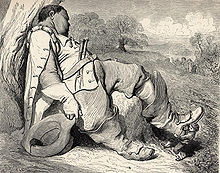
- "Bearskin"
- "The Bee and the Orange Tree"
- "Corvetto"
- "The Dove"
- "The Enchanted Doe"
- "Finette Cendron" or "Cunning Cinders"
- "The Flea"
- "Garulfo"
- "Hop-o'-My-Thumb"
- "Liisa and the Prince"
- "Mr Miacca"
- "Puss in Boots"
- "The Selfish Giant"
- "Sleeping Beauty"
- "Tale of the Ogre"
- "The Three Crowns"
- "Violet"
Gallery
In illustration
-
oil on canvas, c. 1624
-
Gustave Doré (1832–1883): Bluebeard, woodcut from an 1862 edition of Histoires ou contes du temps passé
-
Gustave Doré: Illustration for Le Petit Poucet, 1862
-
Gustave Doré: Illustration for Le Petit Poucet, 1862
-
Alexander Zick (1845–1907): Illustration for Der kleine Däumling
-
The ogre and his wife, illustration for Hop-o'-My-Thumb from a late-19th-century German fairy tale book
-
An oni in pilgrim's clothing
-
Kawanabe Kyōsai (1831–1889): An oni in wandering Buddhist priest's robes, 1864
-
Katsushika Hokusai(1760–1849): An oni being chased away by scattered beans, detail of a print
-
Political cartoon from 1900 depicting Australia as an ogre and referencing its origins as a penal colony
In sculpture
-
An ogre king represented at Mandalay Hill, Myanmar
-
The ogress Sanda Muhki represented at Mandalay Hill
-
A Japanese oni
-
An oni inBeppu, Kyushu
-
Ogre Fountain (lit. "Child Eater Fountain") at Corn House Square, Bern , Switzerland .
See also
References
- .
- ^ Vocabolario Degli Accademici Della Crusca Archived 2007-10-13 at the Wayback Machine
- ^ "Beowulf". Humanities.mcmaster.ca. Retrieved 2012-03-28.
- ^ Dictionnaire de l'Académie française (1932–35)
- ^ ISBN 978-1982122669.
- ^ Croitoriu, Michaël (May–June 1998). "Aide Au Jouer: Talents & Pouvoirs". Backstab (in French). Vol. 9. p. 54.
- ^ Gygax, Gary, and Dave Arneson. Dungeons & Dragons (3-Volume Set) (TSR, 1974)
- ^ Gygax, Gary. Monster Manual (TSR, 1977)
- ^ Gygax, Gary, and Dave Arneson [1974], edited by J. Eric Holmes. Dungeons & Dragons Basic Set (TSR, 1977)
- ^ Gygax, Gary, and Dave Arneson [1974], edited by Frank Mentzer. Dungeons & Dragons Set 1: Basic Rules (TSR, 1983)
- Cook, David, et al. Monstrous Compendium Volume One (TSR, 1989)
- ^ Slavicsek, Bill. Dungeons & Dragons Adventure Game (TSR, 1999)
- ^ Cook, Monte, Jonathan Tweet, and Skip Williams. Monster Manual (Wizards of the Coast, 2000)
- ^ Mearls, Mike, Stephen Schubert, and James Wyatt. Monster Manual (Wizards of the Coast, 2008)
- ^ Slavicsek, Bill. The Complete Book of Humanoids (TSR, 1993)
- ^ Croitoriu, Michaël (November 2000). "Dungeon Master's Guide". Backstab (in French). No. 24. pp. 74–75.
- ^ Eckelberry, David, Rich Redman, and Jennifer Clarke Wilkes. Savage Species (Wizards of the Coast, 2003)
- ISBN 978-0-7645-8459-6. Retrieved 27 March 2012.
- ^ Burak, Alexander (2011). "Some Like It Hot-Goblin-Style: "Ozhivliazh" in Russian Film Translations". Russian Language Journal/Русский Язык. 61: 5–31.
"ogres" - the big, bad guys in the cartoon
- ^ Mussies, Martine (2021). ""Dashing and daring, courageous and caring": Neomedievalism as a Marker of Anthropomorphism in the Parent Fan Fiction Inspired by Disney's Adventures of the Gummi Bears". Dzieciństwo. Literatura i Kultura. 3 (2): 60–83.
Further reading
- Briggs, Kathrine Mary. The Fairies in Tradition and Literature. London: Routledge, 2002.
- "Ogre." Encyclopædia Britannica Online. 15 May 2006, search.eb.com[dead link]
- Rose, Carol. Giants, Monsters, & Dragons: An Encyclopedia of Folklore, Legend, and Myth. New York: ISBN 0-393-32211-4
- Shippey, Tom. The Road to Middle-earth. London: HarperCollins, 1992 (rev.). ISBN 0-261-10275-3
- South, Malcolm, ed. Mythical and Fabulous Creatures: A Source Book and Research Guide. Westport, CT: Greenwood Press, 1987. Reprint, New York: Peter Bedrick Books, 1988. ISBN 0-87226-208-1
External links
 Media related to Ogre at Wikimedia Commons
Media related to Ogre at Wikimedia Commons



